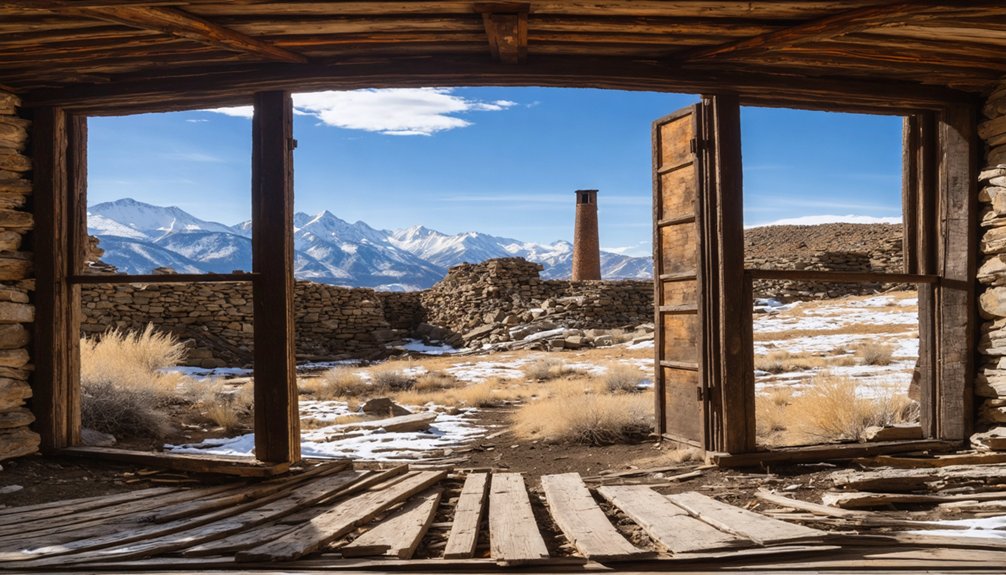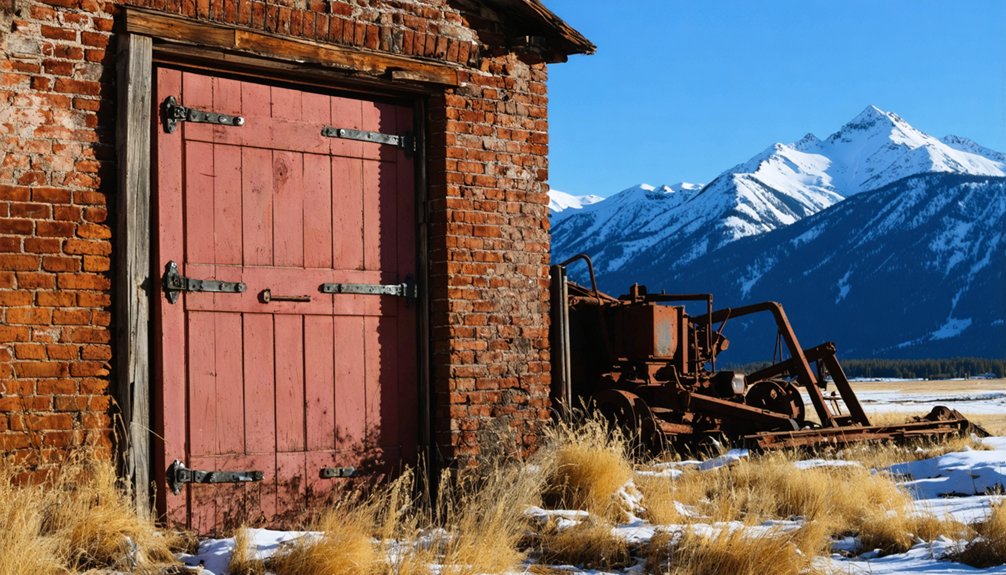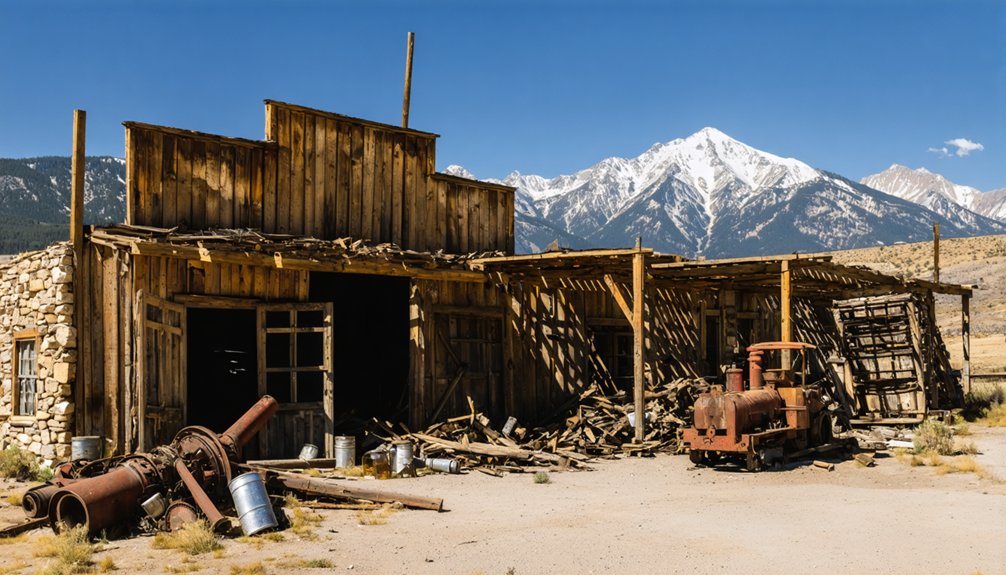Copper City once stood as a high-altitude mining town in Colorado’s Rocky Mountains at 10,000 feet elevation. You’ll find this ghost town‘s remains where prospectors pursued copper dreams from 1907-1942 before operations ceased. The challenging terrain, harsh winters, and limited ore quality led to its swift abandonment. Today, you can explore concrete foundations, wooden beams, and rusting equipment that tell stories of resilient miners who gambled everything on mountain metals.
Key Takeaways
- Copper City was a mining town in Colorado’s Rocky Mountains that operated primarily as an ore processing center from 1907 to 1942.
- The town experienced economic struggles due to low-grade copper deposits, difficult terrain, and transportation challenges.
- Mining operations ceased in 1942, influenced by World War II resource demands.
- Remnants include concrete foundations, wooden beams from the ore mill, and scattered mining equipment.
- Visiting requires a sturdy vehicle with access varying seasonally—summer offers reliable access while winter is nearly impossible.
The Lost Mining Camp in Colorado’s Rocky Mountains
Nestled deep within Colorado’s rugged Rocky Mountains, Copper City stands as a silent monument to America’s ambitious mining past.
You’ll find this ghost town‘s remnants scattered among the peaks, accessible via winding forest service routes that once served as crucial arteries for ore transportation.
What began as a bustling camp centered around copper, silver, and gold extraction now exists only in foundations and memories.
The town developed rapidly following rich mineral discoveries, with saloons and boarding houses springing up to support the miners employing traditional mining techniques like gravity separation. The town sat at an impressive 7,490 feet elevation, creating challenging conditions for year-round mining operations.
Today, you’re free to explore the partially covered mill machinery and support structures, though environmental concerns from heavy metal byproducts have necessitated careful ghost town preservation efforts throughout the area. The area’s history actually places Copper City in Yakama County, Washington, not Colorado as commonly mistaken.
Copper City’s Mining Boom: 1907-1942
When Copper City burst onto Colorado’s mining scene in 1907, few could have predicted its relatively short but impactful 35-year run as a significant ore processing center.
You’d find cutting-edge mining techniques employed here—fine grinding, cyanide treatment, and gravity separation that efficiently extracted copper, gold, and silver from raw ore.
Despite a devastating mill fire in August 1907 causing up to 20% loss in production, operations rebounded by March 1908 with increased capacity.
The Golden Cycle Company’s influence brought cost-reduction innovations that weathered economic fluctuations throughout the decades. This success mirrored the economic efficiency seen at Colorado City’s Golden Cycle Mill in 1907. Unlike the CF&I mining operations in southern Colorado, Copper City avoided the labor disputes that would later erupt into bloodshed during the Colorado Coalfield War.
Workers and families thrived as production peaked, particularly before operations ceased in 1942, likely responding to WWII resource demands.
Today, only concrete foundations remain where once-thundering machinery processed the precious metals that built Colorado’s economy.
Life at 10,000 Feet: The Mining Community
Living at 10,000 feet meant battling nature’s harshest elements while pursuing the promise of mineral wealth. You’d find yourself in rudimentary timber cabins nestled close to mine entrances, with winters that restricted work to just a few months each year.
The thin air made every task more challenging.
Despite these hardships, community resilience thrived in Copper City. The post office became your lifeline to the outside world, while hotels and watering holes offered essential social connection after isolated shifts underground. Judge John S. Wheeler established the town in the 1870s-80s era, transforming it into a bustling logging center.
Your neighbors weren’t just miners—they were loggers and ranchers too, creating a patchwork economy.
Transient lifestyles defined existence here, with workers following ore discoveries and market conditions. You might work the mines in summer, then retreat to lower elevations when snow made the mountains impassable.
Exploring What Remains: Ruins and Relics
The haunting remnants of Copper City’s once-bustling mining operations now emerge from the alpine landscape like ghostly sentinels of a forgotten era.
As you explore, you’ll encounter concrete foundations and wooden beams that once supported the mighty ore mill, now silent witnesses to Colorado’s mining heritage.
Scattered mining equipment and rusting metal fragments tell stories of frontier innovation amid harsh conditions.
The silent language of oxidized gears and broken machinery speaks volumes about human ingenuity in the face of mountain adversity.
The bunkhouse ruins offer glimpses into miners’ daily lives, while artifact preservation remains essential to maintaining the site’s historical integrity.
Similar to Pearl’s history, the area once thrived when copper demand drove mining operations throughout Colorado’s mountainous regions.
Visitors should exercise caution as deteriorating buildings and abandoned mine shafts present dangerous conditions similar to those found at Columbia City.
You’ll notice some areas capped with gravel for environmental containment, as this surplus site underwent cleanup efforts.
While accessible by 4WD vehicles, remember that safety fencing surrounds hazardous sections.
Respect these ruins by leaving artifacts undisturbed—each piece contributes to the collective memory of this remarkable place.
The Copper Dreams That Never Materialized

You’ll find the story of Copper City particularly poignant when you understand how high hopes collided with harsh reality.
The 1892 gold strike at the nearby Orphan mine sparked dreams of prosperity that never translated into the sustained boom early settlers envisioned.
Despite the rich gold-bearing quartz that initially attracted miners, the combination of challenging terrain, transportation difficulties, and the devastating impact of the Sherman Silver Purchase Act repeal in 1893 ultimately prevented Copper City from developing beyond a fleeting moment of excitement.
Failed Economic Promise
While countless Colorado mining towns struck it rich during the late 1800s mineral rush, Copper City‘s economic narrative reads like a cautionary tale of dreams deferred.
You’d have found copper deposits here that simply couldn’t compete with the richer veins of Leadville or Cripple Creek’s gold bonanzas.
Unlike successful boomtowns backed by corporate mining giants, Copper City struggled against volatile mineral prices and inadequate infrastructure. You can imagine investors watching their fortunes evaporate as the ore proved disappointingly low-grade. Without financial investment for digging and refining equipment, Copper City miners couldn’t reach deeper deposits where more valuable ore might have been found.
Without proper smelters or rail connections, even extracting what copper existed became financially unsustainable.
The economic collapse came swiftly. As mining failures mounted, workers fled to more promising districts.
With no diversified economy beyond copper extraction, the town withered, becoming another silent monument to boom-and-bust cycles that defined the frontier’s unforgiving nature.
Boom Without Development
Despite grand prospecting promises that echoed through the Colorado mountains in 1892, Copper City never evolved beyond a rudimentary mining camp into a proper town.
When you visit this ghost town site today, you’ll find little evidence of what might’ve been. The post office operated sporadically until 1915, but the infrastructure never expanded beyond basic mining operations.
While the Orphan mine sparked initial excitement with its high-grade quartz ore, the operation lasted barely a decade with inconsistent production.
The rugged terrain and harsh winters made building a lasting settlement nearly impossible. Transportation challenges limited profitability, while the 1893 Silver Crash delivered a crushing blow to investment.
In Colorado’s mining history, Copper City represents those countless dreams that flashed brilliantly but briefly—another boom without development.
Getting to Copper City: A Rugged Adventure
Reaching Copper City demands three essential preparations: a sturdy vehicle, proper hiking gear, and an adventurous spirit.
The trailhead sits at coordinates 46.8689, -121.2933, where you’ll initiate a relatively short 0.5-mile roundtrip journey across rugged terrain. With minimal elevation gain of just 27 feet, the trail peaks at 4,076 feet.
Currently, the Wildcat Fire has restricted ghost town access, so check conditions before heading out.
The dirt paths can be uneven and overgrown, necessitating sturdy footwear. While some Colorado ghost towns require 4×4 vehicles, many are accessible with 2WD cars when conditions permit. Don’t forget to display your Northwest Forest Pass when parking at the trailhead.
Always bring water, food, and weather-appropriate clothing, and inform someone of your plans before exploring these remnants of yesterday’s dreams.
Photography Tips for Capturing Ghost Town Magic

Capturing the haunting beauty of Copper City requires more than just pointing your camera at decaying structures. Bring a mirrorless or DSLR camera with wide-angle and prime lenses to handle the extreme lighting conditions you’ll encounter. A sturdy tripod isn’t optional—it’s essential for those evocative interior shots.
Start with an establishing shot from high ground to showcase the town’s layout. Then focus on storytelling through details. Windows, rusty hinges, and forgotten artifacts create powerful ghost town photography opportunities. Shoot during golden hour for dramatic lighting that accentuates texture and atmosphere.
When capturing decay, look for peeling paint and weathered wood that reveal the passage of time. Consider black-and-white processing to emphasize texture and timelessness.
Remember—respect the site by leaving everything as you found it.
Seasonal Considerations for Your Visit
When planning your visit to Copper City, timing is everything—each season transforms this mountain ghost town into a completely different experience.
Summer offers the most reliable access with dry roads and comfortable temperatures in the 70-80°F range, perfect for exploring ruins and photography.
Spring brings muddy conditions requiring 4WD vehicles, while fall rewards you with stunning forest colors but risks early snowfall.
Venture between seasons at your own risk—nature rewards the prepared with golden aspens but punishes the unprepared with unexpected snow.
Winter access is nearly impossible without specialized equipment, though animal tracks in pristine snow create a silent, magical landscape for experienced backcountry travelers.
Weather impacts can be dramatic year-round—summer thunderstorms appear suddenly, while winter temperatures plummet below freezing.
Seasonal wildlife sightings increase in warmer months; remain alert for bears and mountain lions.
Pack accordingly: summer demands sun protection and water, while shoulder seasons require layered, waterproof clothing.
Nearby Historical Mining Sites Worth Exploring

While exploring Copper City provides a fascinating glimpse into Colorado’s mining past, the surrounding landscape offers equally compelling historical treasures within easy driving distance.
Don’t miss Central City and Idaho Springs, both within 30-40 miles of Boulder, where you’ll find preserved mines demonstrating historical mining techniques from the 1850s gold rush.
The Orphan Mine in nearby Copper Rock holds particular historical significance as the site of an 1892 strike described as “the greatest in Boulder County for a long time.”
For a fuller picture of Colorado’s mining heritage, venture to Nederland, home to the Caribou mine, or continue to Black Hawk for its mining displays.
These sites collectively tell the story of the Colorado Mineral Belt, the geological wonder that transformed this rugged territory into a bustling industrial frontier.
Frequently Asked Questions
Are There Any Documented Accidents or Deaths at Copper City?
Surprisingly, you’ll find no historical deaths specifically in Copper City ghost town. Accident reports focus on nearby Copper Mountain ski resort, where two teens sadly died sledding in 2023, not the abandoned mining town.
Did Any Famous Individuals Ever Visit Copper City?
No, you won’t find records of famous visitors to this remote outpost. Its limited historical significance and inaccessible location didn’t attract notable figures like larger, more prominent mining towns did.
What Wildlife Might Visitors Encounter Around the Ghost Town?
As shadows dance across crumbling walls, you’ll spot wildlife sightings galore—moose near Tenmile Creek, black bears in forests, eagles soaring overhead, and coyotes prowling at dusk, each with their own wild, untamed behavior.
Is Camping Allowed Near the Copper City Ruins?
Yes, you can camp near Copper City ruins. Dispersed camping regulations allow you to stay up to 14 days, but you’ll need to pack out all trash. Several nearby campgrounds offer more amenities if you’d prefer.
Were Any Significant Mineral Specimens Found at Copper City?
Like buried treasures waiting to be uncovered, you’d find chalcopyrite and pyrite specimens at Copper City. While not world-famous mineral discoveries, these sulfide specimens reflect typical regional mineralization patterns worth exploring.
References
- https://www.denver7.com/news/local-news/colorado-ghost-towns-their-past-present-and-future-in-the-rocky-mountains
- https://westernmininghistory.com/5833/a-tour-of-colorado-mining-towns/
- https://leadville.com/the-ghost-towns-of-leadville-and-beyond/
- https://www.youtube.com/watch?v=3MFkhhtqidw
- https://en.wikipedia.org/wiki/List_of_ghost_towns_in_Colorado
- https://www.colorado.com/articles/colorado-ghost-towns
- https://www.visitouray.com/ghost-towns
- https://www.youtube.com/watch?v=CCXuJJiQDfA
- https://coloradosghosttowns.com/Paradox Colorado.html
- https://westernmininghistory.com/towns/colorado/copper-rock/



